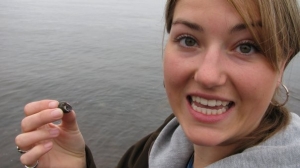Heather Jaggard

B.Sc. (Honours) Thesis
ESTABLISHING DISTRIBUTION OF HG, AS, AND OTHER ELEMENTS WITHIN THE SOILS AT MONTAGUE GOLD DISTRICT, NOVA SCOTIA
(PDF - 26.6 Mb)
Analyses of soil profiles at the Montague Gold District, Nova Scotia indicate the presence of elevated levels of mercury and arsenic, as well as other toxic metals within the soils. Arsenic contamination is a concern in the surrounding environment due to the naturally high levels within the local bedrock. Mercury was added to the environment as a result of gold extraction methods used during mining activities, and is also a concern. Selection of the profiles for geochemical analyses focussed on 4 locations: (1) up-ice from the gold deposits within the District; (2) down-ice from the deposits within the District; (3) a former stamp mill site within the District; and (4) a background site outside the District, with no known associated mineralization. At each of the four sample sites approximately 10 samples were taken from the surface horizons to a depth of 1 meter. All samples were sieved to two size fractions: <63 microns and 2 mm>x>63 microns for geochemical analysis. In general, the finer fraction shows higher metal (and arsenic) concentrations relative to the coarser fraction. At the mill site, soil arsenic levels are as high as 1900 ppm at a depth of 65 cm, and mercury levels reach 50000 ppb at the same depth. Down-ice away from the mill site, concentrations remain elevated for arsenic (400 ppm at depths of 55 cm). Up-ice arsenic levels are lower (maximum 50 ppm at a depth of 10 cm), and background levels outside the District range to a high of 15 ppm at a depth of 100 cm. Mercury drops to a maximum of 300 ppb (at a depth of 5 cm) away from the mill site in any direction. The highest concentrations of metals are found within the organic-rich horizons A0 and A00. Mercury is positively correlated with organic carbon, and also with molybdenum, lead, silver, sulphur, tin, cadmium, vanadium, and sodium. Arsenic shows no correlation with carbon, and has inconsistent correlations with other metals. The higher levels of metals and arsenic at the down-ice location confirms that glacial scouring redistributed higher concentrations of selected elements (in particular arsenic, iron, gold, sulpur, and others) from the mineralized zone in the direction of the advancing ice.
Keywords:
Pages: 163
Supervisors: Anne-Marie Ryan / Terry Goodwin, Nova Scotia Department of Natural Resources



